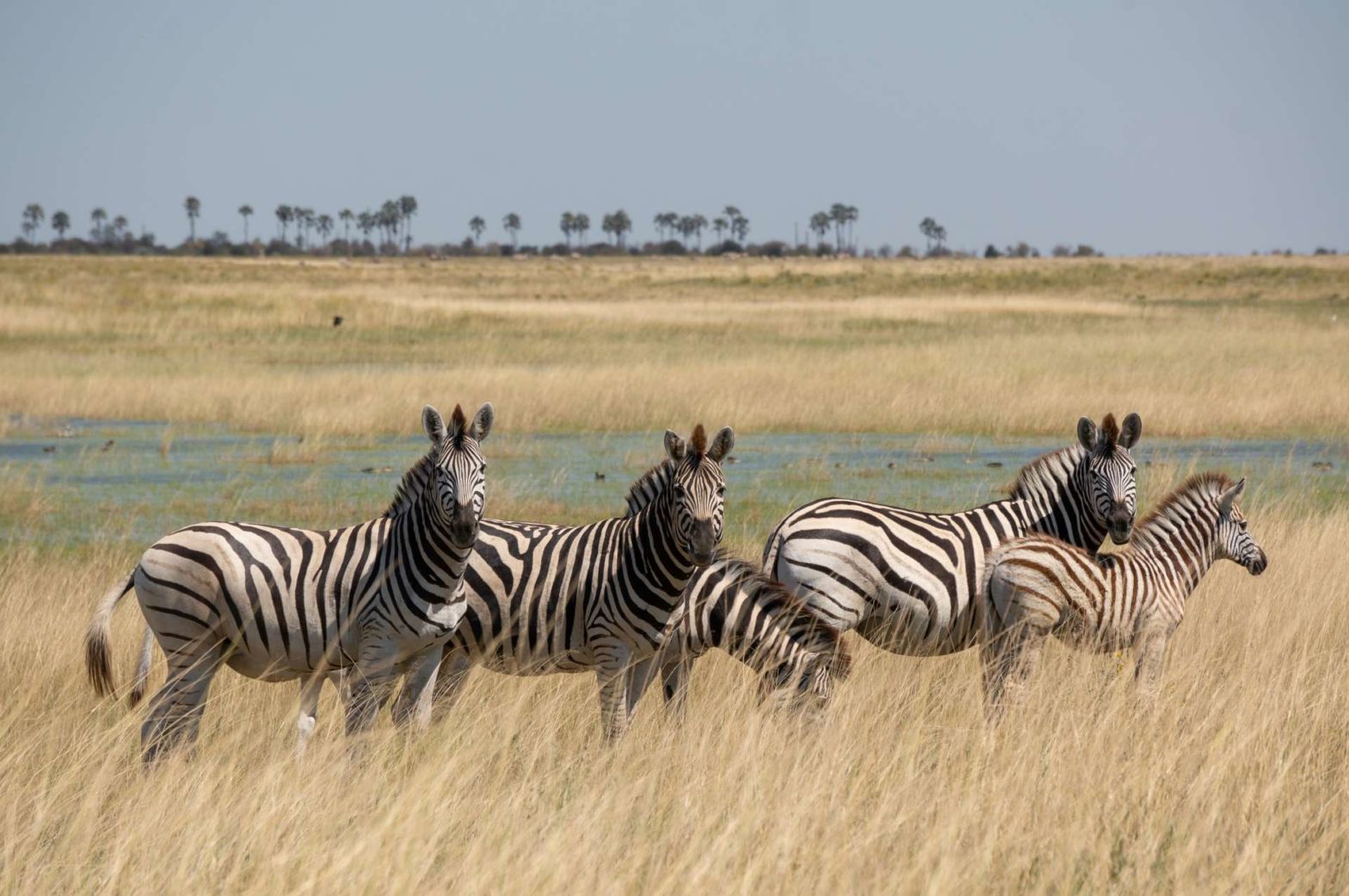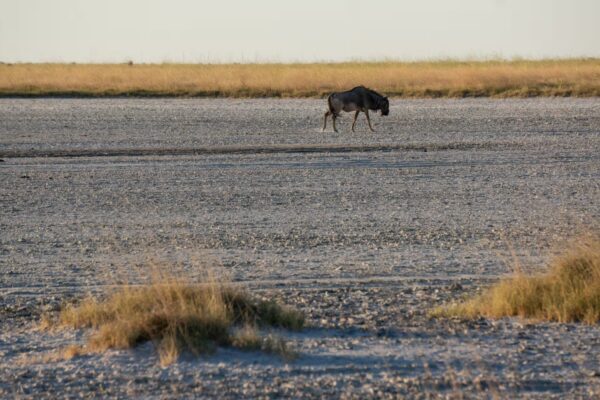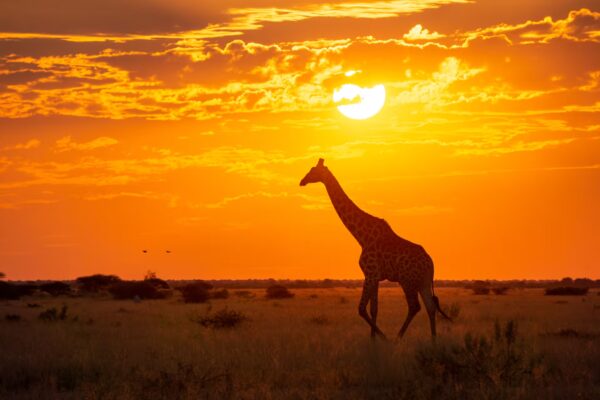By Vicky · Published Dec. 30th, 2021 · Updated Nov. 22nd, 2022
When you buy through links highlighted with an asterisk (*) on this site, we may earn a small affiliate commission at no cost to you.
Makgadikgadi Pans National Park is a huge wilderness and magical safari destination in Botswana, famous for the zebra migration.
Page Contents:
Location
Makgadikgadi Pans National Park is between the A3 and A30 highways in the northeast of Botswana, opposite Nxai Pans. The nearest towns are Gweta (70 km east), Nata (130 km east), Maun (130 km west) and Rakops (70 km south).
Makgadikgadi Pans National Park Map
Tips
- Fuel up in Rakops, Maun or Nata beforehand, there’s no fuel or shops within the park.
- You can rent an equipped 4×4* from Maun or Kasane.
- Pay park conservation fees in advance or have cash.
- The Tracks4Africa Botswana Map* is very useful.
- Prepare for hot days in summer, and freezing nights in winter.
- Why not visit nearby Nxai Pan National Park or Kubu Island.
- For everything outside the park boundaries, check our overall guide to the Botswanan Salt Pans.
- Find the best books to read while in Botswana
- We stopped at Makgadikgadi Pans in the middle of our two-month Botswanan road trip which you can read more about in my book*.
Makgadikgadi Pans National Park is a large park covering part of Nwetwe Salt Pan, an area of grassland full of smaller pans and the Boteti River on its western edge. It’s mainly visited for the wildlife, isolation, and to marvel at the zebra migration which happens when the seasons change.
The wet season (Dec-Apr) is the best time to visit Makgadikgadi Pans as the most game will be in the park, though the roads might be muddy in places. You also won’t be able to reach the edge of the large salt pan itself because the tracks will be flooded.
In dry season you will be able to see the vast, empty salt pan in the southeast of the park, and animals will congregate around the Boteti River on the parks western boundary. At this time of year, the river is full of water from the Angolan Highlands, but the surrounding landscape is bone dry.
When the seasons change, around April and November, it can lead to the best of both worlds, with dry tracks and high concentrations of game.
Makgadikgadi Pans Zebra Migration
The zebra migration of Makgadikgadi Pans is the second-largest land animal migration in the world and takes place twice a year. When the rains begin in Nov/Dec, the zebra head southeast into the normally dry border regions of Nwetwe Pan for the lush grazing. When the rains come to an end around April, the zebra herds trek back northwest across the wilting grasslands to the banks of the Boteti River, to Nxai Pans, and then beyond to the Okavango Delta.
In total the zebras migrate a few hundred kilometres each way, following the rains, with roughly 30,000 animals taking part. From Dec/Jan-April Makgadikgadi Pans will contain many zebra, as they spend the rainy months here. Outside of these months, the great herds will be gone and the desert will become still once more.
Information and Itinerary
There are two main sections of Makgadikgadi Pans National Park, each with its own character.
The Boteti River on the western edge has a high concentration of game, especially in the dry season when the pools here are some of the only water in the park. Seeing the animals involves driving along the riverbed, or the banks when the river is in flood, to the north of the campsite. It can involve some slightly tricky driving heading up and down the riverbanks.
The Boteti River section is the busiest place in the park and contains Khumaga Campsite. On the opposite bank, outside the park, are a few lodges and their guests also visit this section of the park. There are often also cows in the riverbed, since there are villages just outside the park, so it can feel less like a wilderness than elsewhere.
Away from the river to the east, the concentration of game decreases and so does the number of people. The only place to stay here is Tree Island campsite which has three sites. However, the zebras can be found here during their migration from the pans in the east of the park to the Boteti River in the west. Predators can be found tailing the herds. The scenery is unique, with grassy plains surrounding salty white pans, strangely dotted with tall date palms.
Gate Opening Hours
Gate hours of Makgadikgadi Pans National Park are 06:00-18:30 Apr-Sep, 05:30-19:00 Oct-Mar. Make sure you’re back in your campsite outside these hours.
Makgadikgadi Pans National Park Itinerary
We spent one night in the park, camping at Tree Island campsite. On our first day we drove into the park via the northeastern Mokolwane Gate. The ranger on duty here told us that if we headed south we could see the zebra migration. We drove for quite a while and eventually found the zebra, thousands of them surrounding the white pans. However, the ranger informed us we must return the same way because the tracks ahead were still flooded, so we returned to the Mokolwane Gate.
We then headed to Tree Island, our campsite, where we camped in Site 1 with lovely views over a small pan. The following day we headed north and west to the Boteti River section of the park, having a late breakfast near the river. We then drove up and down the river for a few hours, before finally heading north to leave the park via Phuphudu Gate and head onto Nxai Pans National Park just opposite.
Animals we Saw in the Park
I enjoyed seeing the zebras and the remote east of the park. We had the campsite to ourselves and knew nobody else was within tens of kilometres of us, it was wonderful. The landscape by the zebras was unique – it was funny to see the date palm trees. Apparently they grew from seeds dropped by Arabian traders centuries ago.
We didn’t see much game in the east apart from the zebras, though we heard lions roaring during the night. As we approached the Boteti River, the density of game increased and we saw many antelope in the partially wet riverbed along with loads of birds.
As ever, we could have spent another night in the park at Khumaga Campsite but felt we saw a good amount of the park spending only one night. I definitely preferred the atmosphere at Tree Island to Khumaga Campsite, but if you are mainly interested in animals, staying by the Boteti River will be more rewarding.
How to get to Makgadikgadi Pans National Park
There are several entrances to the park, all open 6am-6.30pm Apr-Sep (winter) and 5.30am-7pm Oct-Mar (summer). The main entrance is from Phuphudu Gate in the north, opposite Nxai Pans. A second, exciting way to enter the park is via Khumaga Gate which may involve a ferry crossing though can be impassable at certain times. The third way of entering Makgadikgadi is via the little-used Mokolwane Gate in the parks northeastern corner. There is an old, abandoned and unmanned gate called Xirexare on the parks eastern edge.
Makgadikgadi Pans from Maun or Nxai
Phuphudu Gate is the obvious entrance to use if you’re coming from Maun or Nxai. It’s just south of the A3 highway. Once inside the park, it’s 25 km to Boteti River and a further 5 km to Khumaga Campsite. The turnoff to the east and Tree Island campsite is just by the campsite, while Khumaga Gate is a few kilometres further on.
Makgadikgadi Pans from Rakops & A30
If you’re coming from the south via Rakops, the CKGR or Orapa, you have two options. The first, shortest and most exciting is to cross the Boteti River to reach the Khumaga Gate. In dry season the river is bone dry and you can drive across. When the river is in full flood there is a ferry that will take you across. However, sometimes there’s too much water to drive across but too little for the ferry to work. If so, you must drive 80 km around on tar to reach Phuphudu Gate.
Khumaga Ferry Crossing
The ferry only works when there’s enough water in the River. It’s a pontoon ferry and only takes one car at a time. Once you reach the ferry there is a signboard with a number to call (+267 722 34998) and someone will arrive within 10-15 minutes. If you are stuck, visit Boteti River Camp just up the road to ask for help.
BWP 150 per car, 250 per car and trailer, 75 if staying at Boteti River Camp.
Makgadikgadi Pans from Gweta or Nata
Coming from the east you have two options to enter the park. If you’re only interested in visiting the game-rich Boteti River section of the park, it’s quickest to enter via Phuphudu Gate. If, however, you want to experience the remote east of the park, possibly find the zebras, or camp at Tree Island Campsite, enter via Mokolwane Gate. This gate is not visible from the A3, though it is signed and the track is big and obvious. If you take the direct route, it’s about 75 km to Khamaga Campsite and Boteti River over a mix of hard and thick sandy tracks.
Roads Conditions within Makgadikgadi Pans National Park
We drove 275 km in the park over one afternoon and one morning, camping at Tree Island. We filled up in Nata beforehand (110 km away on tar), visited Nxai Pans the next day and eventually refuelled in Maun (128 km away on tar). The tracks are sandy so expect fuel efficiency within the park to be low (15-20% below normal, or even worse if pulling).
The sandiest tracks in the park were between the east and Boteti River. There were some undulations and thick sand, which could cause trouble for those with trailers. Near the Khumaga entrance gate there is also some thick sand. By the river there can be a bit of up and down the river banks – leave your trailer at camp.
Botswana Overlanding Book
I captured our many adventures in a travel book, check it out on Amazon*.
South Africa was kicking us out so we had to make a plan. ‘What about Botswana?’ A few days before we overstayed our visas, we hit the road in our trusty Defender and sped north from Cape Town.
Self-Drive Safaris in Makgadikgadi Pans National Park
The highest concentration of game within the park is along the Boteti River. There are great game drives to be had driving along the riverbed, or along its banks when the river is in flood. You can spot elephants, many antelope, and hippos lounging in the pools. However, sometimes there are also cows and donkeys in the riverbed.
In the eastern half, game density increases towards Nwetwe Pan in the southeast, with very little game in the vast expanse between the Pan and the River. In the dry season in particular, few animals will be away from the Boteti River, the only source of water in the park at this time. We were here during the zebra migration, we also saw many other antelope and heard lions during the night.
Makgadikgadi Pans National Park Entrance Fees, Camping Rates and Campsite Booking
We ended up booking all our campsites in Botswana via Botswana Footprints who were very professional and their booking fee was surprisingly low. It saves a lot of hassle.
Park fees: The park entrance fee significantly increased in 2022. Now P20/145/190 for citizens/residents & SADC/ international per person per day + vehicle fees per day of P20/75 and trailer fees of P10/40 for local/international. Children 8-15 half price, under 8 free.
SKL Camps manages Khumaga Campsite (Website, TripAdvisor Reviews*) while DWNP manages Tree Island and there is a large difference in price.
Khumaga Campsite: P100/P150/P250/$50 per person per night for citizen/resident/SADC/international. Half-price for kids 8-17 yrs, P20/P40/P60 for kids 5-7, under 5s free.
Tree Island Campsite: P15/30/40 for citizens/residents & SADC/ international per person per night.
Contact details: Contact SKL Group to book Khumaga Campsite. Contact the Department of Wildlife and National Parks (DWNP) to book Tree Island Campsite or to pay conservation fees. Pay in advance and receive a voucher, or pay in cash at the park gates.
Department of Wildlife and National Parks: Botswana Parks and Reserves Reservation Office, +267 397 1405 or +267 318 0774, [email protected]. Office hours 07:30-16:30 on weekdays. Closed weekends.
SKL Camps: +267 686 53 65/6, [email protected], [email protected]. Try contacting them on Facebook or their website.
Campsites in Makgadikgadi Pans National Park
There are two campsites within Makgadikgadi Pans, both with different vibes. There used to be a two-site campsite called Njuca Hills but it is now closed (2021). There is a large price difference between the two campsites, with Tree Island still managed by DWNP and BWP30 per person, while Khumaga is P100 for locals and increases to $50 per person for internationals.
Khumaga Campsite is in the busier, Boteti River section of the park. It’s a developed campsite with proper ablutions, though still unfenced, and there are ten sites all quite close to each other.
Tree Island has three wilderness sites in the eastern plains. It’s wonderfully remote, camping amongst the only trees in an otherwise flat expanse. There isn’t loads of game here, though we did see gemsbok, springbok, zebras and many birds on the pans which were full of water when we visited (mid-April). We also saw a very distant elephant and heard lions roaring during the night.
Khumaga Campsites
There are 10 sites at Khumaga (map↑), an unfenced campsite on the banks of the Boteti River, a few kilometres from Khumaga Gate. The ablutions are clean and well maintained, with hot showers and flushing toilets. All sites are fairly large and have braai areas, and there’s non-potable water available. There isn’t much privacy between sites, and you sometimes get noise from the village across the river. However, it’s in a great location to drive along the river.
Even though it’s on the edge of the river, none of the sites have great river views. Sites 2 and 3 are probably the best as they are on the river side. Often spaces are free if you turn up without a booking, though remember to bring cash. Watch out for the monkeys!
Tree Island Campsites
There are three campsites at Tree Island (map↑) spaced about 50 m apart and quite private because of the trees in between. Tree Island is very obvious from a distance – a raised mound full of trees, distinct from the flat grassland surrounding it.
Site 1 is probably the best as it has the best views, though sites 2 and 3 are also nice. All sites have a bush toilet and bucket shower (bring your own water) but no other facilities. We camped at site 1. Often you’ll be the only campers there.
Site 1: Lovely views over a small pan, a good amount of space and plenty of shade. The toilet and shower enclosures are slightly far away and it’s quite bushy so I was a bit scared.
Site 2: The middle site of the three with decent shade.
Site 3: Furthest from the main track with plenty of shade.
Accommodation outside Makgadikgadi Pans National Park
There are several luxury lodges plus affordable lodges with camping near Makgadikgadi Pans National Park. To learn about those, check out our overall guide to the Botswana Salt Pans. For other parks and places nearby, read about Nxai Pans and Kubu Island.
The Lonely Planet Guidebook* covers all of Botswana, but not in much detail. The Bradt Guide* has a wealth of information and is great for planning a safari around northern Botswana, but doesn’t cover southern Botswana. The Tracks4Africa Map* is an essential item for driving around the country and its national parks. For more information, see our Best Botswana Guidebooks article.
Makgadikgadi Pans National Park was a stop in Botswana on our two-month road trip which you can find out more about by reading the travel adventure book I wrote, No Footprints in the Night: On Safari in Botswana*.
FAQS
The speed limit in Makgadikgadi Pans is 40 km/h.
The wet season, Nov/Dec-Apr is a great time to visit Makgadikgadi, with the zebra here Dec/Jan-Apr. Outside these months game concentrates around the Boteti River so it’s also a nice time.
Makgadikgadi Pans cover an area of 30,000 square kilometres, making it the largest area of salt pans in the world.
Makgadikgadi Pans is between the A3 and A30 highways in the northeast of Botswana, 130 km east of Maun.
You won’t be allowed in Makgadikgadi National Park without a 4×4.
Makgadikgadi means ‘place of many pans’ in the San language.
The entrance fee to Makgadikgadi Pans National Park is P20/145/190 for citizens/residents & SADC/ international per person per day + vehicle fees per day of P20/75 and trailer fees of P10/40 for local/international plates. Children 8-15 half price, under 8 free.








